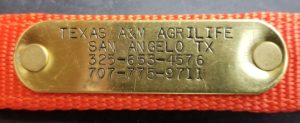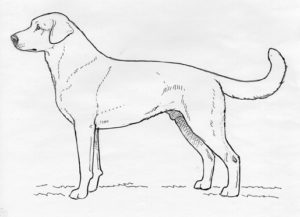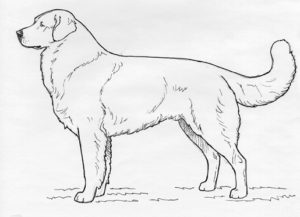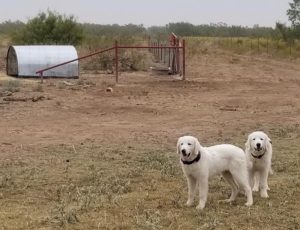Do LGDs need to be aggressive?
If producers feel like they need to find more aggressive dogs they first should determine if they have predators that normal LGDs can’t control. From our experience and discussion with Texas ranchers using LGDs, this is not a problem. On the other hand, issues that are problems with many LGDs, such as roaming, being too fearful of humans, and rough behavior with livestock could be made worse by selecting more aggressive LGDs. While it is important for an LGD to protect their stock, a high level of aggression is not necessarily an important characteristic to have in LGDs. Moreover, aggressive dogs tend to be overly protective of food, water and what they perceive to be their immediate territory. This can lead to ranch personnel, delivery drivers, repairmen and guests being bit if they are working in the dog’s immediate territory. In addition, more aggressive dogs biting people may lead to a lawsuit from an injured individual.
Producers often think that a more aggressive LGD will keep predators away. However, research by Dr. Linda Van Bommel of the Australian National University – Canberra, shows that LGDs do not need to be overly aggressive to keep predators at bay. According to Dr. Bommel’s research, LGDs control predators in three ways: territorial exclusion, disruption and confrontation. Territories are areas that are actively defended and are scent marked with feces and urine by the dogs. Intruders are aggressively chased and physically confronted. Territorial exclusion has been suggested as the major way that LGDs protect livestock, but recent studies from Australia suggest that disruption is more important. LGDs disrupt predator behavior by barking and using aggressive posturing. In the Australian study LGDs and wild dogs had GPS tracking collars and wild dogs routinely entered the LGD territory. These authors described how Maremmas camped amongst the sheep at night in large single flocks, and when disturbed, sheep reacted by flocking together. Maremmas barked aggressively and circled the perimeter of the rotating flock, and a single Maremma left the flock a short distance and challenged the source of the disturbance. The shepherding behavior and aggressive vocalizations of guardian dogs, combined with the flocking behavior of sheep, might circumvent attacks on sheep but did not prevent nor discourage wild dogs from routinely foraging in close proximity to sheep[i]. Rarely is there a direct confrontation between the dog and the predator. In the study above, the only documented direct confrontation resulted in the wild dogs killing the LGD. Most predators in Texas are smaller than a guardian dog. The predator understands that this type of situation will result in a losing battle for them. I do understand that LGDs may catch coyotes and kill them. However, based on our experience and discussion with long time users of LGDs, this is a rare occurrence when you consider the amount of time an LGDs spend with their charges.
The Maremma pups were neutered last month and the Akbash cross pups will be neutered this month. The Maremma pups (“Stooges”) have been released since October 28 into a 100-acre pasture and they have not left the enclosure to date. We are monitoring their movements daily via real time GPS trackers from Digital Matters. The pups are traveling the entire field with their charges. So far Larry and Moe tend to stay together while Curly ventures out on his own regularly. They often show up at one of the bonding pens in the mornings when I go out for their daily check and treat.
All pups have also been micro-chipped now that they are older and moving out into larger pastures. They will receive their permanent collars and an ID tag once they are full grown. The Akbash pups (“Superheroes”) were released on December 3. These pups are doing great and growing rapidly. The dogs along with all the stock from their bonding pens are also wearing GPS trackers. We are tracking the dog’s movement in conjunction with the livestock to see how each set has bonded to the livestock.
LGD Identification: Why it’s important
All dogs at the AgriLi fe Center have three forms of identification on them. We purchase collars that come with a free engraved brass identification tag attached to them. We also use a cattle tag that is imprinted with our name and phone number. These provide easy visual identification of our dogs since several of our neighbors also have LGDs. We also microchip all our dogs in case they ever leave our research ranches and are taken to a local veterinarian or animal shelter. These locations can then read the microchip and contact us regarding our dogs. None of these items are expensive. Our collars cost $10 each, the cattle tags are $1.40 each, and the microchips are $40 each. In total, identification for our dog’s costs $51.40, which is small when com
fe Center have three forms of identification on them. We purchase collars that come with a free engraved brass identification tag attached to them. We also use a cattle tag that is imprinted with our name and phone number. These provide easy visual identification of our dogs since several of our neighbors also have LGDs. We also microchip all our dogs in case they ever leave our research ranches and are taken to a local veterinarian or animal shelter. These locations can then read the microchip and contact us regarding our dogs. None of these items are expensive. Our collars cost $10 each, the cattle tags are $1.40 each, and the microchips are $40 each. In total, identification for our dog’s costs $51.40, which is small when com pared to the average first year cost of $1,750 for an LGD. I also have several pictures of each of our adult dogs on file. Each picture shows a different view of the dog and any special markings. I have them in case a dog shows up at a location that does not have a microchip scanner. I can send those pictures to that person to confirm if the dog is ours or not. Proper identification of ownership is a cheap and easy way to make sure that your LGD is always returned to you if they decide to roam to someplace other than your ranch.
pared to the average first year cost of $1,750 for an LGD. I also have several pictures of each of our adult dogs on file. Each picture shows a different view of the dog and any special markings. I have them in case a dog shows up at a location that does not have a microchip scanner. I can send those pictures to that person to confirm if the dog is ours or not. Proper identification of ownership is a cheap and easy way to make sure that your LGD is always returned to you if they decide to roam to someplace other than your ranch.
Breed Spotlight – Akbash
Akbash are a white livestock guardian dog breed native to western Turkey. Akbash are the Turkish counterpart of the other white guardian breeds found around Europe. However, only Akbash possess the unique combination of Mastiff and gazehound characteristics. Akbash are a long-legged, lean, muscular dog of imposing size and strength, great courage, and stamina, with an alert, regal bearing. Akbash have a long tail, usually carried in a curl over the back. The Akbash possess a unique mixture of characteristics from the Mastiff and gazehound breeds. The gazehound influence gives the breed long legs, a deep chest, arched loin, tucked up flank, speed, and agility. While the Mastiffs contributions can be seen in the breeds height, weight, broader head, and overall impression of power. Their temperament is calm, quiet, independent and capable of responding to changing circumstances without human direction.
They are loyal and gentle with their own family but remain aloof and suspicious toward strangers. They are also watchful of other d og’s and may react aggressively to intrudi
og’s and may react aggressively to intrudi ng dogs. Akbash have a double coat consisting of longer, coarse, outer hairs and dense undercoat of soft, fine hair. Thickness of the undercoat varies significantly with the climate and exposure of the dog to weather. Akbash have two different lengths of body hair and puppies from the same litter can vary in type. The short- coated Akbash (right picture) has body hair that is short to medium in length and lies flat giving a sleek, racy appearance to the dog. The long-coated Akbash (left picture) has body hair that is distinctly longer than on the short-coated dog. The hair is often slightly wavy but is never curled or matted. The long-coated Akbash with full undercoat appears heavier than the medium-coated dog.
ng dogs. Akbash have a double coat consisting of longer, coarse, outer hairs and dense undercoat of soft, fine hair. Thickness of the undercoat varies significantly with the climate and exposure of the dog to weather. Akbash have two different lengths of body hair and puppies from the same litter can vary in type. The short- coated Akbash (right picture) has body hair that is short to medium in length and lies flat giving a sleek, racy appearance to the dog. The long-coated Akbash (left picture) has body hair that is distinctly longer than on the short-coated dog. The hair is often slightly wavy but is never curled or matted. The long-coated Akbash with full undercoat appears heavier than the medium-coated dog.
Males range in height from 30 to 34 inches and females from 28 to 32 inches. Weight should be in proportion to the height, giving a well-muscled, lean appearance without being too light or too heavy. The average weight for a male Akbash in good condition is 120 pounds and for a female, 90 pounds. (Source: https://www.ukcdogs.com/akbash)
LGD Timely Tips:
- Cold weather is here and it’s important that you increase the quality and quantity of feed that is supplied to your LGD. During the colder months your dogs need a higher protein and fat content in their feed to maintain their fat deposits. Fat reserves help maintain the bodies heat level by acting as insulation and a reserve for calories when needed. Make sure that you are providing enough quality feed to maintain a BCS of 5 for you LGDs.
- Most bags of dog kibble have a chart recommending the daily amount to be fed. This is usually listed in cups. A cup is 8 ounces or ½ lb. Most LGDs will need at least 4-6 cups/32-48 ounces/2-3lbs of feed per day to maintain their body condition in the winter. A typical 40lb bag of dog food will last one dog approximately 10 -13 days depending on the weather.
- If you have an LGD with a longer coat, try brushing them during the cooler months. This will keep their coat fluffy which traps air in the hair fibers that acts as insulation to the cold temperatures. The warmer your dog is in the winter, the less it will need to eat to stay warm thus saving money on your feed bill.
To provide feedback on this article or request topics for future articles, please contact me at bill.costanzo@ag.tamu.edu or 325-657-7311.
Bill Costanzo
Research Specialist II, Livestock Guardian Dogs
Follow us on Facebook: https://www.facebook.com/TAMUlivestockguarddog/
Previous Publications and Case Studies
[i] Allen, L. R., N. Stewart-Moore, D. Byrne, and B. L. Allen. 2017. Guardian dogs protect sheep by guarding sheep, not by establishing territories and excluding predators. Animal Production Science 57(6):1118-1127.

